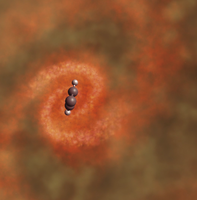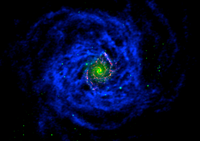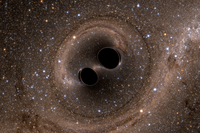Science
Exoplanets, the Solar System and the origins of Stars, Planets and Life
 Circumstellar disks are fundamental to the formation of stars and planets and their evolution places limits on the timescales of both processes. Planets are assembled in disks around pre-main sequence stars and are the means through which chemical enrichment of interstellar material is incorporated into those planets. The physical processes responsible for the assembly and composition of planets and their subsequent dynamical evolution are not fully understood, however. Only recently have optical, infrared, and (sub-)millimeter telescopes achieved the angular resolution required to spatially resolve the innermost regions of nearby disk/planet systems. These efforts have resulted in the discovery of morphological features (rings, spirals, and crescents) in the distribution of circumstellar gas and dust with characteristic sizes on scales of tens of au. These structures are in some cases suggestive of gravitational perturbations of yet unseen giant planets and provide a powerful tool to measure planet masses and orbital radii, study the circumplanetary environment, and investigate how forming planets interact with the circumstellar material. The angular resolution and sensitivity of current multi-wavelength disk imagery is limited to probing for the presence of planets more massive than Neptune at orbital radii larger than 10 au.
Circumstellar disks are fundamental to the formation of stars and planets and their evolution places limits on the timescales of both processes. Planets are assembled in disks around pre-main sequence stars and are the means through which chemical enrichment of interstellar material is incorporated into those planets. The physical processes responsible for the assembly and composition of planets and their subsequent dynamical evolution are not fully understood, however. Only recently have optical, infrared, and (sub-)millimeter telescopes achieved the angular resolution required to spatially resolve the innermost regions of nearby disk/planet systems. These efforts have resulted in the discovery of morphological features (rings, spirals, and crescents) in the distribution of circumstellar gas and dust with characteristic sizes on scales of tens of au. These structures are in some cases suggestive of gravitational perturbations of yet unseen giant planets and provide a powerful tool to measure planet masses and orbital radii, study the circumplanetary environment, and investigate how forming planets interact with the circumstellar material. The angular resolution and sensitivity of current multi-wavelength disk imagery is limited to probing for the presence of planets more massive than Neptune at orbital radii larger than 10 au.
Next generation facilities will expand the parameter space of studied planetary systems, unveiling the formation of planetary systems similar to our Solar System by searching for evidence of planets on orbital radii as small as 0.5 AU at a distance of the most nearby massive star forming regions; detecting planets around lower mass stars; and enhancing our understanding of the limitations on the nature and habitability of detected exoplanets. Ultimately, we should be striving to reach the point where the study of planet formation becomes time-domain science by having the capability to measure the orbital motions of both sub-structures in the distribution of millimeter-size dust particles created by close-in, forming planets as well as fully formed terrestrial worlds.
The origins of protoplanetary disks themselves lie in the processes of star formation, the evolution of molecular clouds through to individual stars and clusters. Next generation facilities will to provide unprecedented insight into the evolution of molecules in the ISM, formation of young stellar objects, high mass stars and the feedback these provide to their surroundings. In particular, astrochemistry enabled by an ngVLA style facility will probe prebiotic molecules that are simply not detectable through single dish surveys, no matter how deep, because resolution is the key element needed to push down past current line confusion limits. These molecular searches trace amino acids, the building blocks of life, as well as the precursor molecules to the amino acids themselves.
Similarly, our own solar system provides constraints on planet formation processes and evolution of planetary systems. Studies of solar system objects In our own Solar System probe the dynamical evolution of our solar system and allow us to understand the composition of comets and planetary atmospheres, revealing the composition of the early solar nebula and the chemistry of current large solar system bodies.
Galaxy Evolution Mechanisms
 The processes that lead to the formation and evolution of galaxies throughout cosmic history involve the complex interplay between hierarchical merging of dark matter halos, accretion of primordial and recycled gas, transport of gas within galaxy disks, accretion onto central supermassive black-holes, and the formation of molecular clouds which subsequently collapse and fragment. The resulting star formation and black-hole accretion provide large sources of energy and momentum that not only light up galaxies but also bring about large changes in their gas reservoirs that we call feedback. How is gas accreted onto galaxies? What regulates the growth of galaxies through cosmic history? How is gas transported within galaxies and expelled by fountains and winds? How is gas inside galaxies influenced by local processes of star formation and black-hole accretion? How do the energetics, turbulent structure, self-gravity, density, and chemical state of the gas change as the gas cycles between different phases, and how do these processes depend on galaxy properties or location in a galaxy?
The processes that lead to the formation and evolution of galaxies throughout cosmic history involve the complex interplay between hierarchical merging of dark matter halos, accretion of primordial and recycled gas, transport of gas within galaxy disks, accretion onto central supermassive black-holes, and the formation of molecular clouds which subsequently collapse and fragment. The resulting star formation and black-hole accretion provide large sources of energy and momentum that not only light up galaxies but also bring about large changes in their gas reservoirs that we call feedback. How is gas accreted onto galaxies? What regulates the growth of galaxies through cosmic history? How is gas transported within galaxies and expelled by fountains and winds? How is gas inside galaxies influenced by local processes of star formation and black-hole accretion? How do the energetics, turbulent structure, self-gravity, density, and chemical state of the gas change as the gas cycles between different phases, and how do these processes depend on galaxy properties or location in a galaxy?
A true physical understanding of these processes is a high-priority goal for astrophysics in the 2030s, and requires facilities with the ability to make precision observations of these processes that will not only constrain the dominant feedback mechanisms and timescales, but also establish useful chemical clocks and produce the observations necessary for interpreting spectroscopy across the universe out to highest redshifts. A new generation of cold gas surveys in galaxies sensitive to early cosmic epochs, along with sub-kiloparsec scale resolution imaging of their gas reservoirs, will provide new insight as to how galaxies accrete, transform, and expel gas. Coupled with a next generation of deep optical studies to understand the stellar populations at these epochs, high-resolution cold gas studies will reveal the detailed physical conditions for galaxy assembly and evolution throughout the history of the Universe.
Black Holes & Transient Phenomena
 While we now know that black holes exist on practically all mass scales, the astrophysics of how these objects form and grow remains a mystery. In the Milky Way galaxy, the number of X-ray binaries (containing stellar mass black holes) is only weakly constrained to be somewhere in the range 102–108 based on a small sample of just 20–30 known Galactic stellar-mass black holes. LIGO is now detecting black holes that are substantially more massive than previously known stellar mass black holes, and observing black hole-black hole mergers — although we do not know how black hole binaries form. While supermassive black holes (SMBHs) are thought to be widespread in galaxy centers, we do not understand how their growth was seeded, or how (and how often) these extreme objects merge.
While we now know that black holes exist on practically all mass scales, the astrophysics of how these objects form and grow remains a mystery. In the Milky Way galaxy, the number of X-ray binaries (containing stellar mass black holes) is only weakly constrained to be somewhere in the range 102–108 based on a small sample of just 20–30 known Galactic stellar-mass black holes. LIGO is now detecting black holes that are substantially more massive than previously known stellar mass black holes, and observing black hole-black hole mergers — although we do not know how black hole binaries form. While supermassive black holes (SMBHs) are thought to be widespread in galaxy centers, we do not understand how their growth was seeded, or how (and how often) these extreme objects merge.
A goal of multi-messenger astronomy in the 2030s is to answer these questions by providing a census of black holes on all mass scales, from stellar-mass to supermassive. This requires facilities that are capable of hunting black holes and surveying the remnants of massive stars to the supermassive black holes that lurk in the centers of galaxies. Such observations must be carried out with high enough angular resolution to separate low-luminosity black holes in our local Universe from background sources, thereby providing critical constraints on their formation and growth. Furthermore, pursuing new facilities with high-resolution, fast-mapping capabilities is required to construct a full physical picture and pinpoint transients associated with violent phenomena such as supermassive black hole mergers and blast waves discovered by some combination of gravitational wave, neutrino, and optical observatories.




Connect with NRAO